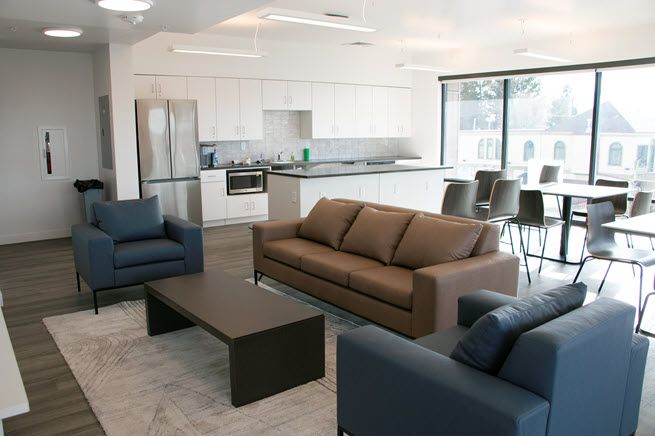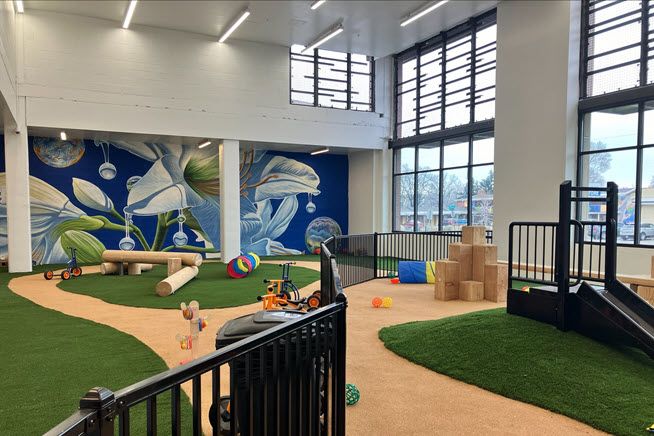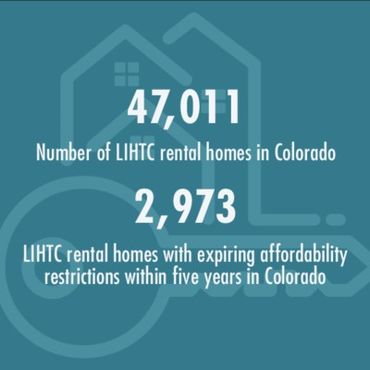The affordable housing business is not for the faint of heart, especially when you’re working to provide safe and secure housing for a population in the 30-70% area median income range during a worldwide pandemic and while experiencing significant cost fluctuations. For Shelly Marquez and her team at Mercy Housing Mountain Plains, though, developing multi-family housing and providing wraparound services for residents is a critical need. It’s a need that they intend to meet for tenants at The Rose on Colfax.
The Rose on Colfax is a new construction mixed-use development with 82 affordable housing units in Denver, Colorado. The development, located in the East Colfax neighborhood, is in a low-income census tract. The five-story complex features one-, two-, three- and four-bedroom apartments. The low-income housing tax credit (LIHTC) development is unusual in that, along with housing, it includes a commercial childcare facility with space for 48 children, including babies, toddlers and preschoolers.

The community room at the five-story Rose on Colfax is available to all residents.
Affordable housing takes multiple streams of funding
This article is based on interviews with Marquez and her colleagues. They provide a picture of how blending multiple streams of funding can bring an affordable housing project to fruition.
Marquez is president of Mercy Housing Mountain Plains, an affiliate of Mercy Housing, which provides affordable housing in seven states – Colorado, Utah, Arizona, Iowa, Missouri, Nebraska and South Dakota. Altogether, the affiliate offers 41 properties with 3,178 units of housing.
In Denver, the total development cost for The Rose on Colfax was more than $32 million, with a per unit cost of $378,260. To reduce ongoing operating costs for the childcare provider, they also conducted a $1.84 million capital campaign to go towards the tenant improvement costs.

The childcare center has space for 48 children, including babies, toddlers and preschoolers.
Project timeline from start to finish
In late 2018 the City and County of Denver opened a competitive request for proposals for a building site to be redeveloped into affordable housing. The project then progressed as follows:
- In the first quarter of 2019, Mercy Housing Mountain Plains received the award.
- In 2020, Mercy Housing Mountain Plains applied for and received LIHTCs. The process took a little over nine months.
- The project broke ground October 2021.
- The certificate of occupancy was obtained late October 2023. The housing was required to be fully leased by the end of the year.
- By January 2024, the early childhood education center was ready to take in children.
Unexpected challenges related to the pandemic and interest rate environment
The pandemic affected various components of the development, including the permit application process. These delays added to the overall project cost:
- Mercy Housing Mountain Plains experienced price increases ranging from 10-15% for materials and labor cost increases above their original 2019 projections. Supply chain disruptions also contributed to the overall project costs. The city assisted with additional funding to address some of the funding gaps.
- An increased interest rate environment also affected the construction. Mercy Housing Mountain Plains had a floating construction loan that increased 4 percentage points. They needed to use some of the hard contingency funds to address the increase.
- Mercy Housing Mountain Plains, like other affordable housing multifamily developers, experienced an increase in insurance costs of approximately 30-50%, depending on the property. The developer expects costs to continue to rise.
Funding affordable housing is a study in complexity
Unlike market-rate development that relies on private equity and debt, an affordable housing development relies on various forms of subsidies to make the rents affordable for low- and moderate-income households. Stacking multiple funding sources can be complex. In this case, ten funding sources were used at different stages of the process
The Rose on Colfax was awarded $11,535,615 in Federal LIHTCs and $4,064,951 in state tax credits. A key requirement of LIHTCs is that projects be in low-to moderate-income (LMI) census tracts.
An additional de facto funding source was the City and County of Denver, which provided the land for just $10 to whichever agency won the competitive request for proposal. According to Marquez, the land was valued at $1,560,000 in 2021 for the site only. If Mercy Housing had to purchase the land it would have required additional funding sources to make the project work.
Early childhood education facility receives private and government funding
Eleven private funders and the City and County of Denver (Denver Office of Children’s Affairs) provided more than $1.8 million in funds for the build out. Grants to the capital campaign ranged in size from $25,000 to $572,000.
Opportunities for banks in new construction
Banks can participate in affordable housing developments in several ways. They can:
- Purchase LIHTCs,
- Participate in Program Related Investment (PRI) type investments,
- Provide below-market loans, and
- Provide unrestricted grants.
The Rose on Colfax is full of the kind of complexities involved in financing affordable housing. The blended financial structure was critical to bringing the project to fruition.
Opportunities for banks in preserving existing affordable housing
There continues to be a tremendous need to preserve existing affordable housing that has expiring affordability restrictions.
Data from the National Housing Preservation Database calculates that almost 3,000 rental homes in Colorado with LIHTCs will have expiring affordability restrictions in the next five years. In the next ten years, that number jumps to more than 12,500. A bright spot for The Rose on Colfax is that a land use restriction on the property ensures affordability for 99 years.

A graphic in teal shows the number of LIHTC rental houses in Colorado - 47,011. Of those, 2,973 will see their affordability restrictions expire within five years.
If you’re in search of affordable housing opportunities to provide loans, investments/grants or to provide community development services you can go to Investment Connection Online and identify housing activities throughout our district. External LinkInvestment Connection - Federal Reserve Bank of Kansas City (kansascityfed.org)
Find national information at External Link2023 Preservation Profiles - National Housing Preservation Database (NHPD)
The views expressed are those of the authors and do not necessarily reflect the positions of the Federal Reserve Bank of Kansas City or the Federal Reserve System.
